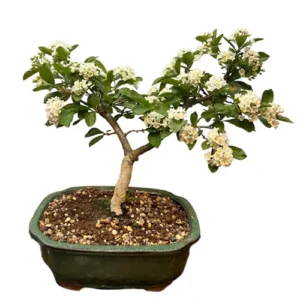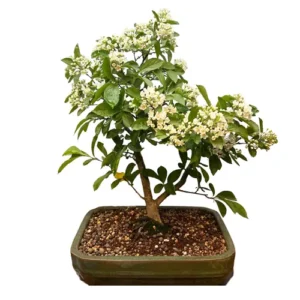Enkianthus Campanulatus
Enkianthus Bonsai
A deciduous shrub found across the woodlands of the Himalayas and Japan. Its sprightly green leaves turn orange-yellow, then red, come Autumn. This species is famously intolerant of lime, any alkaline soils should be eschewed.
Enkianthus Bonsai Care Tips
Placement
Across the spring and Autumn, Enkianthus Bonsai require full sun. During the summer Enkianthus appreciate some shade. This is a frost-hardy species down to temperatures of -5 degrees C.
Watering
Water your Enkianthus Bonsai daily across the growing season.
Feeding & Fertilising
It is necessary to feed Enkianthus Bonsai every two weeks. The soil PH can be balanced out with an ericaceous feed on occasion when necessary.
Pruning & Wiring
New shoot trimming should take place after the flowering has finished throughout the growing season. Robust pruning can be done after the flowering has finished. Be mindful that the plant’s larger scars are slow to heal.
Enkianthus Bonsai can be wired for an array of styles including twin-trunk, slanting, clump and informal upright. We recommend using wires that match the branch’s thickness: if the wire you choose is too thick you will damage the bark. If it is too thin, it won’t be effective.
Repotting
Repotting your tree is an important way to provide a fresh and suitable soil mix and ensure appropriate root health. Enkianthus require repotting every year in early spring. Extending buds are a good indicator of when to repot. Any stone or grit used in soil mix requires washing to remove lime and its traces.
Trees that are ready for repotting will require root pruning, a suitable new pot and appropriate soil mix.
When repotting, do not cut back the root mass by a large amount, and choose a well-draining soil mix that has a neutral or slightly higher PH value of 5-6 but not over 7. We tend to use a mixture of different speciality bonsai soils on our trees. Every species is different so please contact us for free soil-mix advice or to take advantage of our repotting service.
Bonsai trees aren’t only magnificent additions to an indoor oasis, they are more than capable of standing out in any garden. Many Bonsai species are incredibly hardy and withstand nature’s colder and damper turns with aplomb making them worthwhile outdoor plants. We have an extensive library of care guides for outdoor bonsai trees. It’s not about selecting the perfect bonsai, it’s about selecting the perfect bonsai for you.
Enkianthus Bonsai - Typical Queries
How to propagate Enkianthus Bonsai?
Your Enkianthus can be propagated through seeds, cuttings or layers. Seed sowing should take place at the end of spring ideally with temperatures approaching 18 degrees. Semi-ripe cuttings should be taken in the Summer. Ground layering should take place in Autumn. Air layering toward the end of Spring.
Are Enkianthus prone to pests and diseases?
Enkianthus bonsai are not prone to attracting pests. Be watchful however for leaves turning yellow this can be a sign of chlorosis and an indicator the plant is taking in much-hated lime.
Can you keep an Enkianthus bonsai indoors?
It’s best to keep an Enkianthus outdoors, although they do appreciate temperatures between 15-25 degrees C so an outdoor spot is possible with the correct protections from the elements.





















